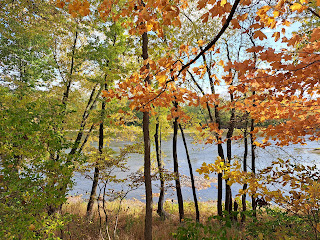Trail: Perimeter Trail
Hike Location: Caesar Creek State Park
Geographic Location: east of Waynesville, OH (39.50078, -84.02068)
Length: 3.6 miles
Difficulty: 4/10 (Moderate)
Dates Hiked: October 1999, October 2022
Overview: An out-and-back to a large recreated pioneer village.
Park Information: https://ohiodnr.gov/go-and-do/plan-a-visit/find-a-property/caesar-creek-state-park
Hike Route Map: https://www.mappedometer.com/?maproute=924326
Photo Highlight:
From the signed trailhead at the back left corner of the mowed-grass area around the 50 Springs picnic shelter, the wide dirt trail heads southwest into young forest. The Perimeter Trail is marked with yellow blazes, and while the blazes are not particularly plentiful, they exist where you need them to stay on the route. After only 0.15 miles, you reach a trail intersection. The option going right leads to the 50 Springs Loop, which encircles its namesake area. Angle left to stay on the Perimeter Trail and head for the pioneer village.
Next the trail dips through the first of many steep but shallow ravines. The difference between maximum and minimum elevations on this hike is only about 75 vertical feet, but there is a lot of up and down on this hike. The forest on the next ridge is quite young, and it features some red cedar trees along with some osage orange trees. Both of these trees indicate that this land was farmed in the not too distant past.
At 0.5 miles, the trail curves left to start following an old barbed wire fence, another remnant of this land's agricultural past. A pond with lots of lily pads appears downhill to the right. At 0.7 miles, you cross a bridge over Jonahs Run. A small scenic waterfall named Crawdad Falls sits just below this bridge, but the seasonally dry conditions ensured that no water was falling when I hiked here in late October.
Some black walnut trees appear in the forest before you intersect an old asphalt road at 0.8 miles; this road is closed to vehicles. As directed by signs and yellow blazes, you want to turn left to hike 0.2 miles uphill on the old road before turning right to reenter the forest on single track dirt trail. The young forest with a dense understory of honeysuckle continues, as do the shallow but steep ravines.
At 1.7 miles, you reach Pioneer Village Road, an asphalt road that is open to vehicles. Turn right and hike a short distance on the road to reach the pioneer village. The village consists of 25 structures, most of which were moved here from other points in the Caesar Creek area; some of them would have been submerged by the construction of Caesar Creek Lake. The structures include several log cabins, a couple of barns, a general store, and a meeting house. The Perimeter Trail traces a 13 mile loop around the southern portion of Caesar Creek Lake, but the pioneer village is a nice turnaround point for a dayhike. Thus, I turned around here and retraced my steps to the 50 Springs area to complete my hike.
Hike Location: Caesar Creek State Park
Geographic Location: east of Waynesville, OH (39.50078, -84.02068)
Length: 3.6 miles
Difficulty: 4/10 (Moderate)
Dates Hiked: October 1999, October 2022
Overview: An out-and-back to a large recreated pioneer village.
Park Information: https://ohiodnr.gov/go-and-do/plan-a-visit/find-a-property/caesar-creek-state-park
Hike Route Map: https://www.mappedometer.com/?maproute=924326
Photo Highlight:
Hike Video:
Directions to the trailhead: Northeast of Cincinnati, take I-71 to SR 73 (exit 45). Exit and go west on SR 73. Drive SR 73 west 4.2 miles to the signed entrance for the park's 50 Springs Group Camp on the left. Turn left to enter the park, and park in the first parking lot on the left near the picnic shelter.
The hike: For my general comments on Caesar Creek State Park and its Perimeter Trail, see my earlier hike on a section of the Perimeter Trail near the dam's Visitor Center on the other side of the lake. The section of the Perimeter Trail described here follows a buried cable corridor for most of its distance, and therefore the scenery gets a little mundane. However, this section ends at the Caesar Creek Pioneer Village, a large collection of log cabin-type buildings most of which date to the early 1800's. This section also passes a small waterfall, so this hike has rewards even if the route to get to them is occasionally uninspiring.
 |
| Trailhead at 50 Springs picnic shelter |
 |
| Hiking the Perimeter Trail |
 |
| Old barbed wire fence |
 |
| Jonahs Run and Crawdad Falls |
 |
| Pioneer village across a field |
 |
| Log cabin in pioneer village |





































